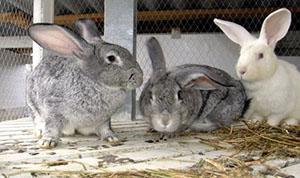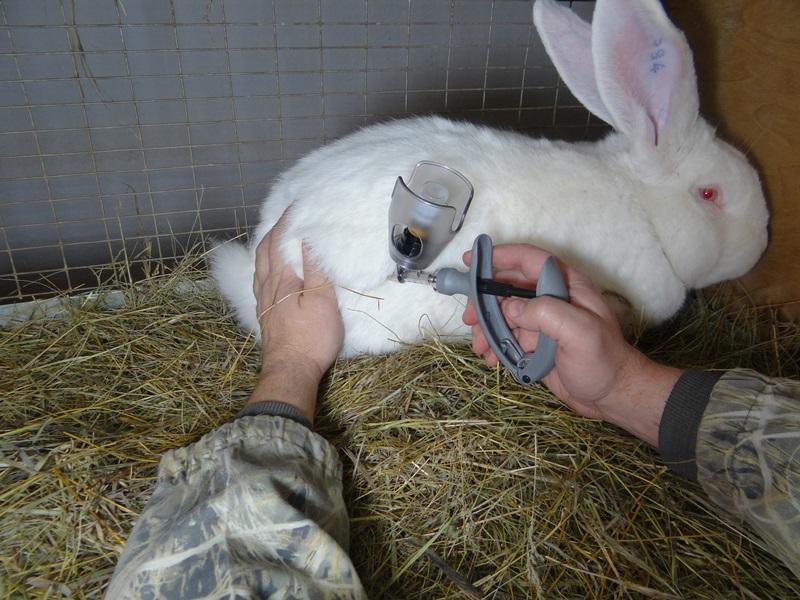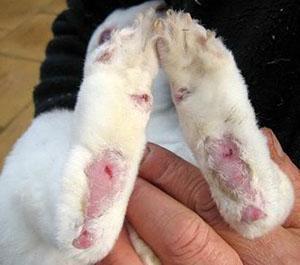Prevention, symptoms and treatment of rabbit diseases
 Rabbits are susceptible to a large number of infections that are better prevented than combated. The main diseases of rabbits and their symptoms, and treatment should be known to any farmer in order to help animals in time. In addition, preventive measures must be taken.
Rabbits are susceptible to a large number of infections that are better prevented than combated. The main diseases of rabbits and their symptoms, and treatment should be known to any farmer in order to help animals in time. In addition, preventive measures must be taken.
Disease prevention
Rabbits purchased from another farm must be kept in a separate cage for 3 weeks. If during this time the symptoms of any diseases do not appear, you can add them to other animals. Inspection of young rabbits and adults should be carried out regularly before mating.

A healthy rabbit is vigorous, has a good appetite, has a shiny coat, calm breathing, and clean eyes and ears. If any deviations in his condition are noticeable, it is better to call a doctor right away. It is recommended to slaughter a sick rabbit to prevent the spread of the disease.
The most common diseases of rabbits and their treatment
All diseases of rabbits can be roughly divided into two groups: non-infectious and infectious. The first group includes eating disorders. Such diseases of rabbits, their symptoms and treatment have long been widely known. Eating disorders are usually caused by poor quality feed in adults or the transition to rigid food in rabbits after breast milk. The presence of the disease is determined by the absence of bowel movements, too loose stools, and bloating.
In this case, the rabbit should be kept on a starvation diet for about 12 hours, and then feed it with a mixture of soft food and boiled potatoes. If the animal suffers from constipation, they give Glauber, Carlsbad salt or castor oil by teaspoon by mouth. In rabbits, diarrhea is treated with a solution prepared from 2 liters of water and one synthomycin tablet. They should be given to animals in the morning and evening. After a few days, foodborne illness in rabbits and their symptoms disappear with this treatment.
 It is not uncommon for animals to injure themselves in the cage. All kinds of damage to the body of rabbits are also non-infectious diseases. If the bruise is small, then after a few days it goes away on its own. To cope with small wounds in which the integrity of the skin is violated, you can lubricate them with iodine. Deep injuries in rabbits are difficult to cure, so these animals are usually killed immediately. Fractures of the legs occur when animals fall into the cracks in the cage. Rabbits still live with such an injury for a very long time. It is unprofitable and expensive to treat a fracture, so the animal is also killed.
It is not uncommon for animals to injure themselves in the cage. All kinds of damage to the body of rabbits are also non-infectious diseases. If the bruise is small, then after a few days it goes away on its own. To cope with small wounds in which the integrity of the skin is violated, you can lubricate them with iodine. Deep injuries in rabbits are difficult to cure, so these animals are usually killed immediately. Fractures of the legs occur when animals fall into the cracks in the cage. Rabbits still live with such an injury for a very long time. It is unprofitable and expensive to treat a fracture, so the animal is also killed.
You should protect rabbits in cold weather, as they can freeze their ears. If this happens, the animal must be placed in a warm room. Frostbite areas are gently greased with melted warm fat.
Like humans and many other animals, rabbits are susceptible to heat and sunstroke. It can be determined by the following symptoms: the rabbit is motionless and lies on its side, the eyelids, mouth and nose are reddened, breathing is rapid.A compress helps to cope with the effects of heat and sunstroke. The towel should be applied to the rabbit's head, constantly wetting it in cold water. If convulsive twitching of the limbs is observed, it will no longer be possible to cure the animal. It remains to score it.
Colds in rabbits develop if they are in a draft for a long time or get caught in the rain. Animals sneeze, clear discharge is visible from the nose. The rabbits need to be transferred to a warm place, a few drops of furacilin solution are instilled into the nose every day, for the preparation of which 1 g of the substance is diluted in 100 g of water. Even if rabbits have had non-infectious diseases, their meat can be used without restrictions. The situation is different in the case of infectious infections.
Infectious diseases of rabbits: symptoms and their treatment, photo
To know how and how to treat a sick animal, you must be able to recognize diseases.
Coccidiosis in rabbits
 It is caused by parasitic protozoa - coccidia. Coccidiosis is dangerous because it causes damage to the liver and intestines. The causative agents of the disease enter the body through water, mother's milk and feed. The reason for the development of coccidiosis is also a large number of rabbits in a cage, an unbalanced diet, and a violation of sanitary and hygienic nutritional standards. Symptoms of the disease are constipation, diarrhea, bloating, lack of appetite, tousled fur on the abdomen, and general weakness.
It is caused by parasitic protozoa - coccidia. Coccidiosis is dangerous because it causes damage to the liver and intestines. The causative agents of the disease enter the body through water, mother's milk and feed. The reason for the development of coccidiosis is also a large number of rabbits in a cage, an unbalanced diet, and a violation of sanitary and hygienic nutritional standards. Symptoms of the disease are constipation, diarrhea, bloating, lack of appetite, tousled fur on the abdomen, and general weakness.
You can cope with the disease by eliminating all the reasons that provoked its development. In addition, the drug Baycox for rabbits is often used in accordance with the instructions. This is the most effective remedy, according to most experts, in the treatment of coccidiosis. It can also be applied to poultry and ornamental animals.
The method of using the drug is determined by its concentration. Therefore, before using it, you should carefully read the instructions.
Another well-known drug is Solicox for rabbits. The instruction for this drug characterizes it as a drug with a wide spectrum of action. Solicox helps to cope with all types of coccidiosis pathogens in rabbits. It works well with other medicines and various supplements.
It is important that Solikox is low-toxic, therefore safe in case of overdose.
Myxomatosis in rabbits
 This acute disease manifests itself in the form of tumors and gelatinous edema on the skin, redness of the eyelids and auricles. Myxomatosis usually causes death of animals. To avoid it, rabbits should be vaccinated. With the spread of myxomatosis, all livestock are divided into two groups. The first includes infected individuals, which are immediately killed. All cells, dishes after them are recommended to be destroyed. The second group includes healthy livestock, which are slaughtered for meat. Given that the treatment of myxomatosis is impossible, it is only possible to prevent this disease through prevention.
This acute disease manifests itself in the form of tumors and gelatinous edema on the skin, redness of the eyelids and auricles. Myxomatosis usually causes death of animals. To avoid it, rabbits should be vaccinated. With the spread of myxomatosis, all livestock are divided into two groups. The first includes infected individuals, which are immediately killed. All cells, dishes after them are recommended to be destroyed. The second group includes healthy livestock, which are slaughtered for meat. Given that the treatment of myxomatosis is impossible, it is only possible to prevent this disease through prevention.
Rabbit hemorrhagic disease
 The main areas of the disease are the liver and lungs of animals. It spreads very quickly, with an incubation period of several hours. Rabbits may have cramps, nosebleeds, general weakness, and fever. Infection occurs through a litter or feeder that was used for a sick animal, through direct contact with a carrier of the disease. Treatment is not possible, but there is a special serum that can protect rabbits for 2 hours. During this time, it is necessary to remove them from sick animals.
The main areas of the disease are the liver and lungs of animals. It spreads very quickly, with an incubation period of several hours. Rabbits may have cramps, nosebleeds, general weakness, and fever. Infection occurs through a litter or feeder that was used for a sick animal, through direct contact with a carrier of the disease. Treatment is not possible, but there is a special serum that can protect rabbits for 2 hours. During this time, it is necessary to remove them from sick animals.
Ear mite
 Infection with them rabbits occurs from the mother, with scales of the skin of a sick animal in adults. The spread of the ear mite occurs more actively when rabbits live crowded. The symptoms of the disease are clearly visible externally in the form of crusts on the inner surface of the ears.In addition, the rabbit actively scratches them, trying to get rid of these formations on the skin. Treatment of an ear mite in rabbits is carried out with the help of regular treatment of the ears with a special mixture, which includes creolin, turpentine, kerosene and glycerin.
Infection with them rabbits occurs from the mother, with scales of the skin of a sick animal in adults. The spread of the ear mite occurs more actively when rabbits live crowded. The symptoms of the disease are clearly visible externally in the form of crusts on the inner surface of the ears.In addition, the rabbit actively scratches them, trying to get rid of these formations on the skin. Treatment of an ear mite in rabbits is carried out with the help of regular treatment of the ears with a special mixture, which includes creolin, turpentine, kerosene and glycerin.
Hello, this is my misfortune, the rabbits are dying seemingly healthy, but by the evening the corpse is already felt by the ridge and hunched over like butoh and they are thin lungs kagbudto die of hunger. When feeding, they pounce on food and drink. I feed with hay also give grain. Tell me what and how to treat.
Call your veterinarian immediately. If there is no specialist nearby, contact your nearest veterinary pharmacy. If the animals are not gaining weight, then there is a strong worm infestation. Explain the problem at the pharmacy and they will find a medicine for you. Be sure to take antibiotics and vitamins to strengthen the immunity of the remaining animals. The constant thirst of animals is the first signal of gastric problems.
A female rabbit which was a year old had partially paralyzed hind legs. She ate little and drank almost nothing. She was beaten and opened, she had growths on the liver and in the mother liquor area. Lungs, heart and kidneys are not damaged. What could it be. With what and what could cause this disease. And is it contagious?
You had to take the animal to the veterinary clinic. Only by examining the insides of the animal will the veterinarian make an accurate diagnosis. We cannot make diagnoses in absentia.
Hello, please tell me what kind of disease my rabbit has (something with the eye) than to treat if honestly never faced rabbits and so the pain of the disease. Is there a veterinarian to consult?
Your rabbit has myxomatosis. Read what and how to do in the article.